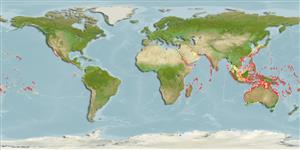分类 / Names
俗名 | 同种异名 | Catalog of Fishes(属, 种) | ITIS | CoL | WoRMS | Cloffa
Teleostei >
Gobiiformes (Gobies) >
Gobiidae (Gobies) > Gobionellinae
Etymology: Gnatholepis: Greek, gnathos = jaw + Greek,lepis = scale (Ref. 45335).
More on author: Bleeker.
Environment: milieu / climate zone / depth range / distribution range
生态学
海洋; 半咸淡水 礁区鱼类; 深度上下限 1 - 46 m (Ref. 11441). 熱帶
Indo-Pacific: Persian Gulf (Ref.80050) and Red Sea and East Africa to the Hawaiian, Marquesan and Society islands.
印度-太平洋: 紅海而且東非到夏威夷,馬貴斯群島與社會群島。
大小 / 重量 / 年龄
Maturity: Lm ? range ? - ? cm
Max length : 8.4 cm SL 雄鱼/尚未辨别雌雄; (Ref. 41653)
背棘 (总数): 6 - 7; 背的软条 (总数): 11; 臀棘 1; 臀鳍软条: 11. Distinguished by the following characteristics: ctenoid scales on head, predorsal midline and pectoral fin base, distinct flap present at end of lower lip; at least three dark spots along first spine of first and second dorsal fins, followed by at least three rows of dark spots or short streaks, pectoral fin with rows of fine dark and white speckles; second dorsal and anal fin rays nearly always I,11; pectoral rays 14-17, modally 16; lateral scales 25-29, modally 27; predorsal scales 7-13, usually 9-10, mostly ctenoid, may be cycloid anteriorly or toward midline; body compressed, width at anus 11.9-28.1% (mean 15.2%) of SL; body stocky in appearance, body depth at anus 19.6-26.6% of SL, body depth at first dorsal fin origin 14.3-27.7% of SL; head compressed, broader ventrally, slightly deeper than wide, HL 26.6-33.3% of SL; head depth at posterior preopercular margin 62.0-83.7% of HL; head width at posterior preopercular margin 53.7-82.2% of HL; head profile bluntly pointed; nape slightly convex behind eyes; mouth subterminal to nearly terminal, slightly oblique; jaws generally reaching to below anterior margin of eye; upper jaw length 32.0-41.5% of HL; upper lip smooth, narrower than lower, lower lip papillose close to teeth, with twist or fold posteriorly, forming triangular flap, lip interrupted at chin; eye moderate to relatively small in large specimens, dorsolateral, 22.7-30.5% of HL; preorbital width 18.2-27.8% of HL; snout bluntly pointed, 22.4-44.4% of HL; posterior naris round to almost triangular, close to anterior margin of eye; anterior naris in short tube, higher on posterior margin of eye, about level with middle of eye or somewhat ventral to it; interorbital narrow, 4.7-11.3% of HL; caudal peduncle compressed, length 12.9-18.6% (mean 16.1%) of SL; caudal peduncle depth 10.7-13.8% of SL (Ref. 92171).
身体有一系列的 6个细长垂直的暗色斑块沿着身体的下侧, 在形成一个从胸鳍的在下面上半部到尾鳍的基底中点的列的每个暗色的斑块上具有一个水平的数列深褐色的点或者短的深褐色的线; 一系列的比较少量明显的暗色斑块在身体背面, 不和低的斑块 , 与在暗色的斑块上趋向形成群的很多的小深褐色的点成一直线。 [标本从西南太平洋与深色的栖息地, 例如在火山的沙子上, 在身体上可能有连续的黑色线条]. 一个大的深褐色的斑块包含在胸鳍基底上面的一个小的鲜黄色的斑点。 在眼睛中央之下的在颊上的一条狭窄的,垂直的,和深褐色的到黑色的横带;(有时有 1 或 2 短的斜支流) 一条狭窄的黑色横带通常成一直线具有或者正好位于瞳孔的后缘前。 在鳃盖上的一个斜的深色印记。 在第 6 到第 7个鳍条的水平在胸鳍基底上的一条暗色的斑纹而且延伸到鳍的近端部份。 背鳍与尾鳍鳍有很多的小褐色斑点。 在胸鳍上的第二背鳍鳍与有很多的深色点的每个在动脉之间薄膜上大的成鱼有一个长的褐色条纹。 颊位于前深色的横带眼睛下面通常有一些小鳞片。 延伸至的腹鳍前的鳞片垂直的在前鳃盖骨的后面边缘。 嘴些微下方, 口裂些微斜。 在纵向的系列 30 中的鳞片. 横跨的鳞片系列 9.5. 伪鳃丝状突起 6.(参考文献 41653)
Solitary or in loose groups in sand (Ref. 90102). Inhabits shallow coastal bays and estuaries on silty sandy substrates with sparse algae-reef or seagrasses (Ref. 48637). Benthic (Ref. 58302). Feeds on organic matter and small invertebrates (Ref. 89972).
栖息于水浅的近岸海湾与河口淤泥的之上沙的有稀疏的的底部藻类礁石或海草.(参考文献 48637)
Life cycle and mating behavior
成熟度 | 繁殖 | 产卵场 | 卵 | 孕卵数 | 仔鱼
Benthic spawner.印度-太平洋: 紅海而且東非到夏威夷,馬貴斯群島與社會群島。
Randall, J.E. and D.W. Greenfield, 2001. A preliminary review of the Indo-Pacific gobiid fishes of the genus Gnatholepis. Ichthyological Bulletin of the J.L.B. Smith Institute of Ichthyology, 69:1-17. (Ref. 41653)
人类利用
渔业: 低经济
更多信息
参考文献养殖养殖信息品种遗传学Electrophoreses遗传率疾病加工NutrientsMass conversion
合作者照片Stamps, Coins Misc.声音神经毒速度泳型鳃区Otoliths脑重体重比眼睛色素
工具
特别资料
下载 XML
网络资源
Estimates based on models
Preferred temperature (Ref.
123201): 24.3 - 29, mean 27.7 °C (based on 808 cells).
Phylogenetic diversity index (Ref.
82804): PD
50 = 0.5010 [Uniqueness, from 0.5 = low to 2.0 = high].
Bayesian length-weight: a=0.00977 (0.00442 - 0.02163), b=3.05 (2.86 - 3.24), in cm total length, based on LWR estimates for this (Sub)family-body shape (Ref.
93245).
营养阶层 (Ref.
69278): 3.4 ±0.4 se; based on size and trophs of closest relatives
回复力 (Ref.
120179): 高度, 族群倍增时间少于 15个月 (Preliminary K or Fecundity.).
Fishing Vulnerability (Ref.
59153): Low vulnerability (10 of 100).
Nutrients (Ref.
124155): Calcium = 133 [66, 296] mg/100g; Iron = 0.882 [0.415, 1.694] mg/100g; Protein = 18.2 [16.2, 20.0] %; Omega3 = 0.155 [0.068, 0.290] g/100g; Selenium = 23.3 [11.6, 57.7] μg/100g; VitaminA = 117 [29, 421] μg/100g; Zinc = 2.85 [1.88, 4.34] mg/100g (wet weight);
